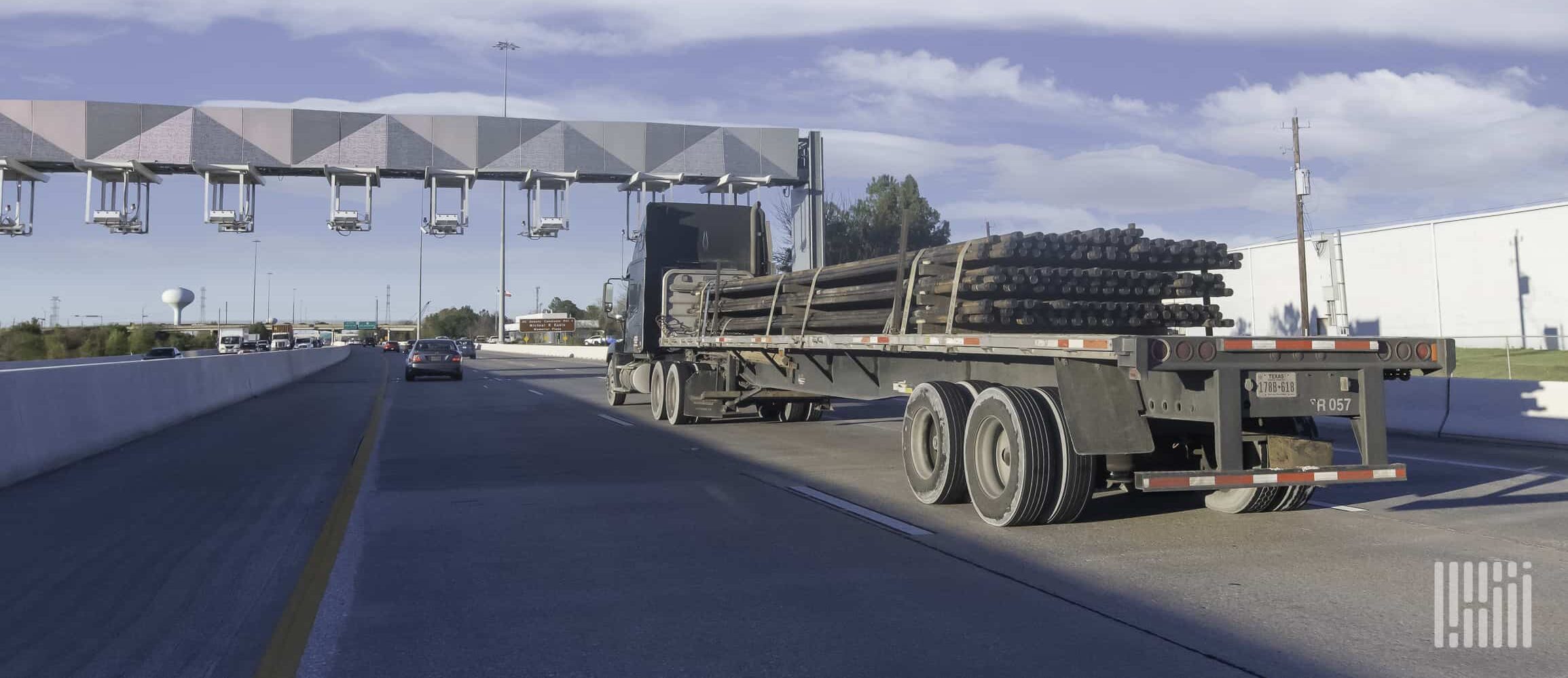When Cleveland horseless carriage manufacturer Alexander Winton finished building his first 22 vehicles in 1889, he was in a bind. Automobiles were still such a recent invention that he couldn’t deliver his orders without putting miles on the new cars. To address the issue, he built a new vehicle capable of pulling a flatbed trailer loaded with a single car.
Winton would probably barely recognize today’s trucks as descendants of his original innovation, but the trailer remains fairly similar. When something massive needs to be moved, we still turn to some version of the now-classic flatbed trailer. There’s a configuration available to carry the widest and heaviest of loads; learn which one is right for your cargo.
What is a flatbed trailer?
Along with enclosed dry vans and refrigerated reefers, flatbeds are among the most commonly used semi-truck trailers on roads today. With no roof or sides, they can carry loads that are too tall, wide or long for conventional dry vans. Generally flatbeds carry around 48,000 pounds of cargo, but the maximum amount depends on the tractor’s weight. Flatbeds are also used for heavy hauling, which in special circumstances may entail carrying loads exceeding 100,000 pounds.
Along with the complexity of hauling bulky, high-value goods unprotected from outdoor elements, flatbed drivers must manage considerable safety risks. In the wrong hands, transporting unusually sized cargo on public roads can be highly dangerous. Accordingly, flatbed drivers require more training and are typically better paid than dry van drivers, contributing to higher shipping rates. Read the FreightWaves article Why is flatbed trucking so dangerous? to learn more about the risks that flatbed drivers face.
Examples of items shipped by flatbed include construction equipment, scrap metal, shipping containers and all sorts of vehicles.
What are the types of flatbed trailers?
Although the original flatbed design is still apparent in today’s standard version, the ensuing years have brought many variations. These innovations were designed with two major needs in mind. Some provide additional space, allowing trucks to carry more or longer pieces of cargo than legal flatbeds in one load. They may also enable heavy or oversized loads to meet federal or state weight and dimensional safety regulations. What they all have in common is their lack of permanent side and roof enclosures, which means more cargo flexibility.
The three most common flatbed types available for five-, six- and seven-axle trucks are the:
- Legal (the standard version with one deck height)
- Step-deck (also known as drop-deck or, less commonly, single drop)
- Lowboy (also known as double-drop)
There are variations of each of these three flatbed types. These include:
- Stretch (extendable) versions – stretch trailers offer additional flexibility in terms of length, but are much heavier than normal trailers. As a result, the amount of cargo they can carry is less than with a non-extendable trailer.
- Removable gooseneck
- Rolling tarp/Conestoga systems
Eight-axle trailers are also available in standard and lowboy configurations. Specialized nine-axle trucks capable of hauling up to 110,000 pounds are occasionally driven on public roads with an escort.
Cargo examples and their recommended flatbed trailer type
Based on the cargo you intend to carry, one of the following flatbed trailer types will probably work:
Construction materials, industrial equipment, lumber, steel coils
Legal flatbed – Standard flatbeds are good for all kinds of cargo, as long as it doesn’t exceed regulatory limits.
Length: 48’ or 53’
Deck height: 5’
Width: 8.5’
Max height (deck + cargo): 8.5’
Max weight (trailer + cargo): 48,000 lbs.
Coils, concrete products, pipes, turbines
Step-deck/ drop-deck – These trailers feature a second deck that’s longer and lower than the one located closer to the tractor. Lower decks can carry loads that otherwise would exceed height restrictions.
Length: 48’ or 53’
Deck height: 3′ – 3’6″
Width: 8.5’
Upper deck length: 8′ – 12′
Lower deck length: 37′ – 43′
Max height (deck + cargo): 10’
Max weight (trailer + cargo): 48,000 lbs.
Backhoe loaders, bulldozers, excavators
Lowboy/ double-drop – Similar to step-decks, but with three decks and (usually) a gooseneck. The highest deck sits behind the gooseneck, the longest and lowest in the middle “well,” and one at a middle height that starts just before the wheels. Since most of a lowboy’s length is lower to the ground than step-decks, lowboys can carry taller equipment.
Length: 48’
Max cargo length: 29’
Deck height: 18″ to 24″
Width: 8.5’
Upper deck lengths: 6′ – 10′
Lower deck length: 29′
Max height (deck + cargo): 11.5’ – 12′
Max weight (trailer + cargo): 42,000 – 45,000 lbs.
Heavy machinery, specialty vehicles, tractors
Removable gooseneck (RGN) – RGNs are trailers with detachable pieces of equipment that act as a ramp. They allow for freight to be driven in and out of the lowest deck in the middle section. They can be any type of flatbed, but are usually lowboys.
Lumber, machinery, odd-sized loads, steel
Conestoga – Trailers featuring collapsible, accordian-style tarps that can easily be pulled over or off freight. They enable easy loading and unloading (from the side or above, for instance) that isn’t possible with a dry van. They also provide the protection of a dry van when the tarp is extended to cover the load during transit. While standard flatbed Conestogas are most popular, step-deck and lowboy Conestogas are also produced.
For information on trailers carrying cargo that isn’t heavy or oversized, read Which semitruck trailer is best for your load?
Find the right flatbed trailer trucking company
With so many trailer configurations, sizes and options, searching for the right company to move your cargo may feel overwhelming. If your shipment is oversized or heavy, flatbeds are the right place to start. Knowing the differences between types and what they typically carry will help you narrow down the perfect fit. Read Top flatbed trucking companies to learn which businesses specialize in the type of flatbed you need.
FAQ
A trailer with a flat level bed and no fixed sides or roof, normally 48 or 53 feet in length. Along with enclosed dry vans and refrigerated reefers, flatbeds are among the most commonly seen semi-truck trailers on roads today. They can carry loads that are too tall, wide or long for conventional dry vans.
Common examples of loads shipped on flatbed trucks include heavy machinery, construction equipment, steel beams, architectural glass, mobile homes, military equipment or vehicles.
As of June 2022, the national average flatbed hauling service rate was $3.46 per mile. However, the total price of transporting goods via flatbed will depend on several factors, like weight, distance, fuel costs, etc. Read Flatbed hauling services: how it works, rates, pros & cons for more details.


